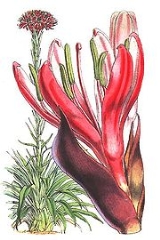
Gymea Lily
Encyclopedia
The Gymea Lily is a flowering plant
indigenous to the coastal areas of New South Wales
near Sydney
.
The plant has sword-like leaves more than a meter long. It flowers in spring and summer, sending up a flower spike up to 6 m high, which at its apex bears a large cluster of bright red flowers, each 10 cm across.
The name "Gymea Lily" is derived from a local Eora
dialect. Dory-anthes means spear-flower in Greek, and excelsa is Latin for exceptional. The Sydney suburbs of Gymea
and Gymea Bay
are named after the lily.
.
Aboriginal people in the Lake Macquarie district of NSW were observed in 1836 roasting the stems, having cut them when half a meter high and as thick as a person's arm. They also roasted the roots which they made into a sort of cake to be eaten cold.
Flowering plant
The flowering plants , also known as Angiospermae or Magnoliophyta, are the most diverse group of land plants. Angiosperms are seed-producing plants like the gymnosperms and can be distinguished from the gymnosperms by a series of synapomorphies...
indigenous to the coastal areas of New South Wales
New South Wales
New South Wales is a state of :Australia, located in the east of the country. It is bordered by Queensland, Victoria and South Australia to the north, south and west respectively. To the east, the state is bordered by the Tasman Sea, which forms part of the Pacific Ocean. New South Wales...
near Sydney
Sydney
Sydney is the most populous city in Australia and the state capital of New South Wales. Sydney is located on Australia's south-east coast of the Tasman Sea. As of June 2010, the greater metropolitan area had an approximate population of 4.6 million people...
.
The plant has sword-like leaves more than a meter long. It flowers in spring and summer, sending up a flower spike up to 6 m high, which at its apex bears a large cluster of bright red flowers, each 10 cm across.
The name "Gymea Lily" is derived from a local Eora
Eora
The Eora are the Aboriginal people of the Sydney area, south to the Georges River, north to the Hawkesbury River, and west to Parramatta. The indigenous people used this word to describe where they came from to the British. "Eora" was then used by the British to refer to those Aboriginal people...
dialect. Dory-anthes means spear-flower in Greek, and excelsa is Latin for exceptional. The Sydney suburbs of Gymea
Gymea, New South Wales
Gymea is a suburb in southern Sydney, in the state of New South Wales, Australia. Gymea is located 26 kilometres south of the Sydney central business district in the local government area of the Sutherland Shire. The postcode is 2227, which it shares with adjacent suburb Gymea Bay.-History:The...
and Gymea Bay
Gymea Bay, New South Wales
Gymea Bay is a suburb in southern Sydney, in the state of New South Wales, Australia. Gymea Bay is located 27 kilometres south of the Sydney central business district, in the local government area of the Sutherland Shire...
are named after the lily.
History
The genus Doryanthes was first described in 1802 by the Portuguese priest, statesman, philosopher and botanist José Francisco Correia de Serra (1750–1823), a close friend of Sir Joseph Banks. Doryanthes excelsa has also inspired the naming of Doryanthes, the journal of history and heritage for Southern Sydney founded by Dharawal historian Les BursillLes Bursill
Leslie William Bursill is a Dharawal historian, archaeologist, anthropologist, and publisher, born in Hurstville, New South Wales, on 4 February 1945. His father Wallace Richard Bursill was serving in the 7th Div AIF in New Guinea at the time of Bursill's birth...
.
Aboriginal use
Honey-eaters love the nectar of these large, crimson flowers on stems 2–3 m tall. These birds were ready prey to be cooked and eaten!Aboriginal people in the Lake Macquarie district of NSW were observed in 1836 roasting the stems, having cut them when half a meter high and as thick as a person's arm. They also roasted the roots which they made into a sort of cake to be eaten cold.

